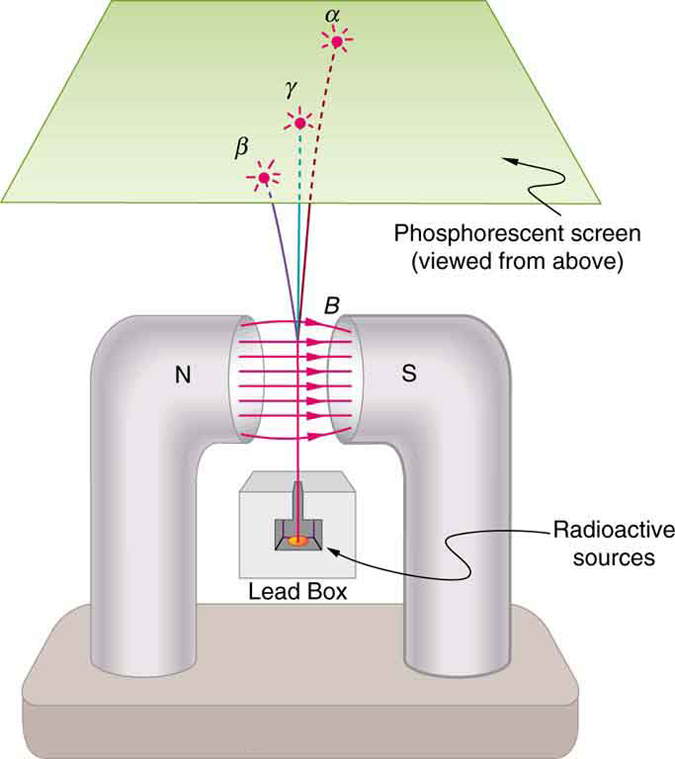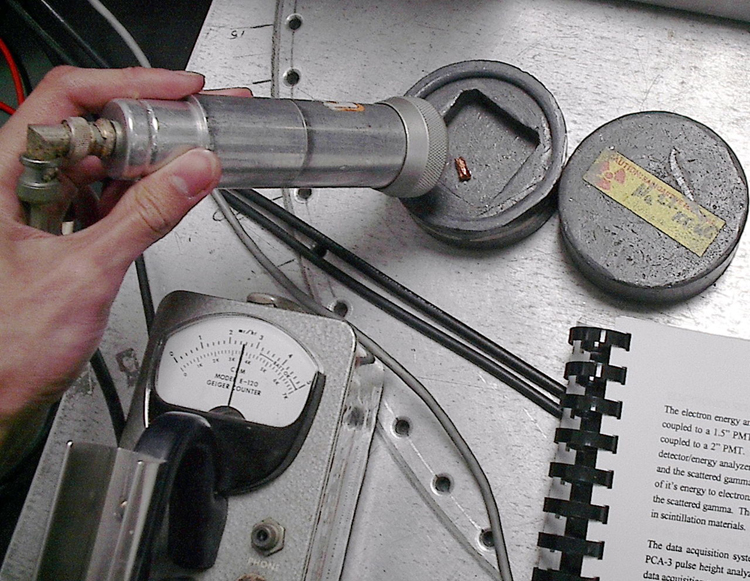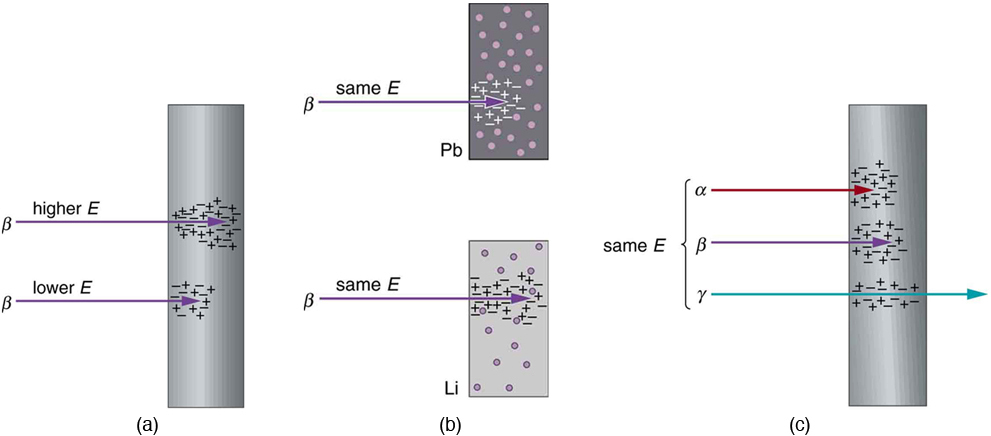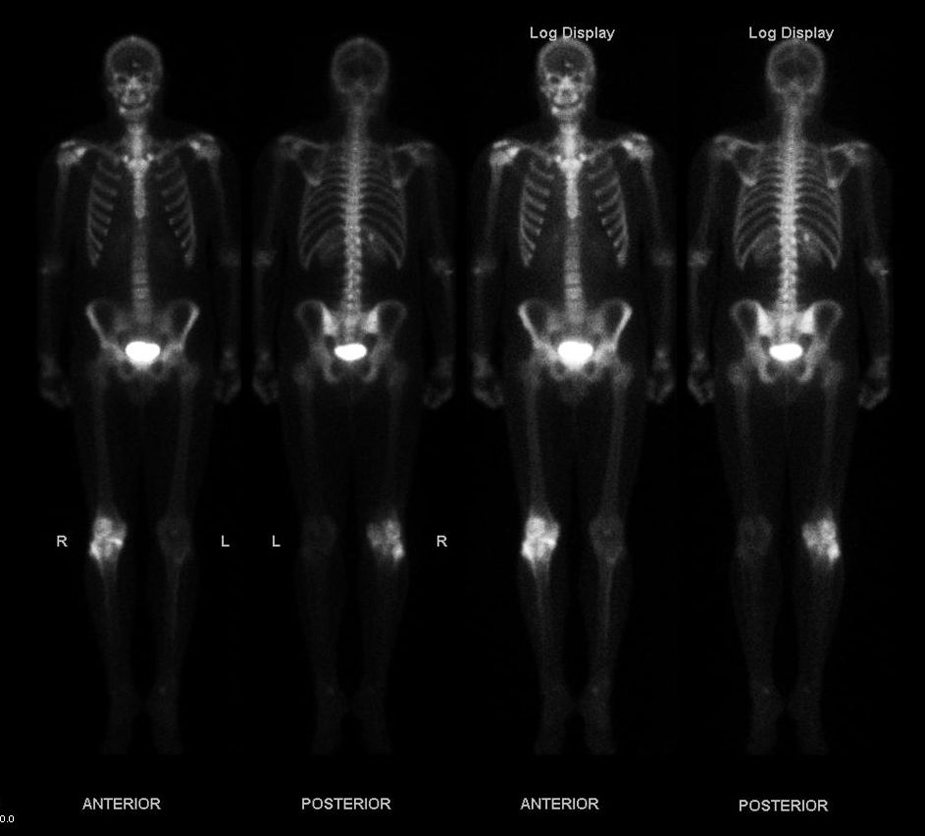Chapter 31 Radioactivity and Nuclear Physics
31.1 Nuclear Radioactivity
Summary
- Explain nuclear radiation.
- Explain the types of radiation—alpha emission, beta emission, and gamma emission.
- Explain the ionization of radiation in an atom.
- Define the range of radiation.
The discovery and study of nuclear radioactivity quickly revealed evidence of revolutionary new physics. In addition, uses for nuclear radiation also emerged quickly—for example, people such as Ernest Rutherford used it to determine the size of the nucleus and devices were painted with radon-doped paint to make them glow in the dark (see Figure 1). We therefore begin our study of nuclear physics with the discovery and basic features of nuclear radioactivity.

Discovery of Nuclear Radioactivity
In 1896, the French physicist Antoine Henri Becquerel (1852–1908) accidentally found that a uranium-rich mineral called pitchblende emits invisible, penetrating rays that can darken a photographic plate enclosed in an opaque envelope. The rays therefore carry energy; but amazingly, the pitchblende emits them continuously without any energy input. This is an apparent violation of the law of conservation of energy, one that we now understand is due to the conversion of a small amount of mass into energy, as related in Einstein’s famous equation [latex]{E=mc^2}[/latex]. It was soon evident that Becquerel’s rays originate in the nuclei of the atoms and have other unique characteristics. The emission of these rays is called nuclear radioactivity or simply radioactivity. The rays themselves are called nuclear radiation. A nucleus that spontaneously destroys part of its mass to emit radiation is said to decay (a term also used to describe the emission of radiation by atoms in excited states). A substance or object that emits nuclear radiation is said to be radioactive.
Two types of experimental evidence imply that Becquerel’s rays originate deep in the heart (or nucleus) of an atom. First, the radiation is found to be associated with certain elements, such as uranium. Radiation does not vary with chemical state—that is, uranium is radioactive whether it is in the form of an element or compound. In addition, radiation does not vary with temperature, pressure, or ionization state of the uranium atom. Since all of these factors affect electrons in an atom, the radiation cannot come from electron transitions, as atomic spectra do. The huge energy emitted during each event is the second piece of evidence that the radiation cannot be atomic. Nuclear radiation has energies of the order of [latex]{10^6 \;\text{eV}}[/latex] per event, which is much greater than the typical atomic energies (a few [latex]\text{eV}[/latex]), such as that observed in spectra and chemical reactions, and more than ten times as high as the most energetic characteristic x rays. Becquerel did not vigorously pursue his discovery for very long. In 1898, Marie Curie (1867–1934), then a graduate student married the already well-known French physicist Pierre Curie (1859–1906), began her doctoral study of Becquerel’s rays. She and her husband soon discovered two new radioactive elements, which she named polonium (after her native land) and radium (because it radiates). These two new elements filled holes in the periodic table and, further, displayed much higher levels of radioactivity per gram of material than uranium. Over a period of four years, working under poor conditions and spending their own funds, the Curies processed more than a ton of uranium ore to isolate a gram of radium salt. Radium became highly sought after, because it was about two million times as radioactive as uranium. Curie’s radium salt glowed visibly from the radiation that took its toll on them and other unaware researchers. Shortly after completing her Ph.D., both Curies and Becquerel shared the 1903 Nobel Prize in physics for their work on radioactivity. Pierre was killed in a horse cart accident in 1906, but Marie continued her study of radioactivity for nearly 30 more years. Awarded the 1911 Nobel Prize in chemistry for her discovery of two new elements, she remains the only person to win Nobel Prizes in physics and chemistry. Marie’s radioactive fingerprints on some pages of her notebooks can still expose film, and she suffered from radiation-induced lesions. She died of leukemia likely caused by radiation, but she was active in research almost until her death in 1934. The following year, her daughter and son-in-law, Irene and Frederic Joliot-Curie, were awarded the Nobel Prize in chemistry for their discovery of artificially induced radiation, adding to a remarkable family legacy.
Alpha, Beta, and Gamma
Research begun by people such as New Zealander Ernest Rutherford soon after the discovery of nuclear radiation indicated that different types of rays are emitted. Eventually, three types were distinguished and named alpha ([latex]{\alpha}[/latex]), beta ([latex]{\beta}[/latex]), and gamma ([latex]{\gamma}[/latex]), because, like x-rays, their identities were initially unknown. Figure 2 shows what happens if the rays are passed through a magnetic field. The [latex]{\gamma}[/latex] s are unaffected, while the[/latex]latex{\alpha}[/latex] s and [latex]{\beta}[/latex] s are deflected in opposite directions, indicating the [latex]{\alpha}[/latex] s are positive, the [latex]{\beta}[/latex] s negative, and the [latex]{\gamma}[/latex] s uncharged. Rutherford used both magnetic and electric fields to show that [latex]{\alpha}[/latex] s have a positive charge twice the magnitude of an electron, or [latex]{+2 |q_e|}[/latex]. In the process, he found the [latex]{\alpha}[/latex] s charge to mass ratio to be several thousand times smaller than the electron’s. Later on, Rutherford collected [latex]{\alpha}[/latex] s from a radioactive source and passed an electric discharge through them, obtaining the spectrum of recently discovered helium gas. Among many important discoveries made by Rutherford and his collaborators was the proof that [latex]{\alpha}[/latex] radiation is the emission of a helium nucleus. Rutherford won the Nobel Prize in chemistry in 1908 for his early work. He continued to make important contributions until his death in 1934.

Other researchers had already proved that [latex]{\beta}[/latex] s are negative and have the same mass and same charge-to-mass ratio as the recently discovered electron. By 1902, it was recognized that [latex]{\beta}[/latex] radiation is the emission of an electron. Although [latex]{\beta}[/latex] s are electrons, they do not exist in the nucleus before it decays and are not ejected atomic electrons—the electron is created in the nucleus at the instant of decay.
Since [latex]{\gamma}[/latex] s remain unaffected by electric and magnetic fields, it is natural to think they might be photons. Evidence for this grew, but it was not until 1914 that this was proved by Rutherford and collaborators. By scattering [latex]{\gamma}[/latex] radiation from a crystal and observing interference, they demonstrated that [latex]{\gamma}[/latex] radiation is the emission of a high-energy photon by a nucleus. In fact, [latex]{\gamma}[/latex] radiation comes from the de-excitation of a nucleus, just as an x ray comes from the de-excitation of an atom. The names "[latex]{\gamma}[/latex] ray" and "x ray" identify the source of the radiation. At the same energy, [latex]{\gamma}[/latex] rays and x rays are otherwise identical.
| Type of Radiation | Range |
|---|---|
| [latex]{\alpha}[/latex] -Particles | A sheet of paper, a few cm of air, fractions of a mm of tissue |
| [latex]{\beta}[/latex] -Particles | A thin aluminum plate, or tens of cm of tissue |
| [latex]{\gamma}[/latex] Rays | Several cm of lead or meters of concrete |
| Table 1: Properties of Nuclear Radiation | |
Ionization and Range
Two of the most important characteristics of [latex]{\alpha}[/latex], [latex]{\beta}[/latex], and [latex]{\gamma}[/latex] rays were recognized very early. All three types of nuclear radiation produce ionization in materials, but they penetrate different distances in materials—that is, they have different ranges. Let us examine why they have these characteristics and what are some of the consequences.
Like x rays, nuclear radiation in the form of [latex]{\alpha}[/latex] s, [latex]{\beta}[/latex] s, and [latex]{\gamma}[/latex] s has enough energy per event to ionize atoms and molecules in any material. The energy emitted in various nuclear decays ranges from a few [latex]\text{keV}[/latex] to more than [latex]{10 \;\text{MeV}}[/latex], while only a few [latex]{\text{eV}}[/latex] are needed to produce ionization. The effects of x rays and nuclear radiation on biological tissues and other materials, such as solid state electronics, are directly related to the ionization they produce. All of them, for example, can damage electronics or kill cancer cells. In addition, methods for detecting x rays and nuclear radiation are based on ionization, directly or indirectly. All of them can ionize the air between the plates of a capacitor, for example, causing it to discharge. This is the basis of inexpensive personal radiation monitors, such as pictured in Figure 3. Apart from [latex]{\alpha}[/latex], [latex]{\beta}[/latex], and [latex]{\gamma}[/latex], there are other forms of nuclear radiation as well, and these also produce ionization with similar effects. We define ionizing radiation as any form of radiation that produces ionization whether nuclear in origin or not, since the effects and detection of the radiation are related to ionization.

The range of radiation is defined to be the distance it can travel through a material. Range is related to several factors, including the energy of the radiation, the material encountered, and the type of radiation (see Figure 4). The higher the energy, the greater the range, all other factors being the same. This makes good sense, since radiation loses its energy in materials primarily by producing ionization in them, and each ionization of an atom or a molecule requires energy that is removed from the radiation. The amount of ionization is, thus, directly proportional to the energy of the particle of radiation, as is its range.

Radiation can be absorbed or shielded by materials, such as the lead aprons dentists drape on us when taking x rays. Lead is a particularly effective shield compared with other materials, such as plastic or air. How does the range of radiation depend on material? Ionizing radiation interacts best with charged particles in a material. Since electrons have small masses, they most readily absorb the energy of the radiation in collisions. The greater the density of a material and, in particular, the greater the density of electrons within a material, the smaller the range of radiation.
Collisions
Conservation of energy and momentum often results in energy transfer to a less massive object in a collision. This was discussed in detail in Chapter 7 Work, Energy, and Energy Resources, for example.
Different types of radiation have different ranges when compared at the same energy and in the same material. Alphas have the shortest range, betas penetrate farther, and gammas have the greatest range. This is directly related to charge and speed of the particle or type of radiation. At a given energy, each [latex]{\alpha}[/latex], [latex]{\beta}[/latex], or [latex]{\gamma}[/latex] will produce the same number of ionizations in a material (each ionization requires a certain amount of energy on average). The more readily the particle produces ionization, the more quickly it will lose its energy. The effect of charge is as follows: The [latex]{\alpha}[/latex] has a charge of [latex]{+2q_e}[/latex] , the [latex]{\beta}[/latex] has a charge of [latex]{-q_e}[/latex] , and the [latex]{\gamma}[/latex] is uncharged. The electromagnetic force exerted by the [latex]{\alpha}[/latex] is thus twice as strong as that exerted by the [latex]{\beta}[/latex] and it is more likely to produce ionization. Although chargeless, the [latex]{\gamma}[/latex] does interact weakly because it is an electromagnetic wave, but it is less likely to produce ionization in any encounter. More quantitatively, the change in momentum [latex]{\Delta p}[/latex] given to a particle in the material is [latex]{\Delta p =F \Delta t}[/latex], where [latex]{F}[/latex] is the force the [latex]{\alpha}[/latex], [latex]{\beta}[/latex], or [latex]{\gamma}[/latex] exerts over a time [latex]{\Delta t}[/latex]. The smaller the charge, the smaller is [latex]{F}[/latex] and the smaller is the momentum (and energy) lost. Since the speed of alphas is about 5% to 10% of the speed of light, classical (non-relativistic) formulas apply.
The speed at which they travel is the other major factor affecting the range of [latex]{\alpha}[/latex] s, [latex]{\beta}[/latex] s, and [latex]{\gamma}[/latex] s. The faster they move, the less time they spend in the vicinity of an atom or a molecule, and the less likely they are to interact. Since [latex]{\alpha}[/latex] s and [latex]{\beta}[/latex] s are particles with mass (helium nuclei and electrons, respectively), their energy is kinetic, given classically by [latex]{\frac{1}{2} mv^2}[/latex]. The mass of the [latex]{\beta}[/latex] particle is thousands of times less than that of the [latex]{\alpha}[/latex] s, so that [latex]{\beta}[/latex] s must travel much faster than [latex]{\alpha}[/latex] s to have the same energy. Since [latex]{\beta}[/latex] s move faster (most at relativistic speeds), they have less time to interact than [latex]{\alpha}[/latex] s. Gamma rays are photons, which must travel at the speed of light. They are even less likely to interact than a [latex]{\beta}[/latex], since they spend even less time near a given atom (and they have no charge). The range of [latex]{\gamma}[/latex] s is thus greater than the range of [latex]{\beta}[/latex] s.
Alpha radiation from radioactive sources has a range much less than a millimeter of biological tissues, usually not enough to even penetrate the dead layers of our skin. On the other hand, the same [latex]{\alpha}[/latex] radiation can penetrate a few centimeters of air, so mere distance from a source prevents [latex]{\alpha}[/latex] radiation from reaching us. This makes [latex]{\alpha}[/latex] radiation relatively safe for our body compared to [latex]{\beta}[/latex] and [latex]{\gamma}[/latex] radiation. Typical [latex]{\beta}[/latex] radiation can penetrate a few millimeters of tissue or about a meter of air. Beta radiation is thus hazardous even when not ingested. The range of [latex]{\beta}[/latex] s in lead is about a millimeter, and so it is easy to store [latex]{\beta}[/latex] sources in lead radiation-proof containers. Gamma rays have a much greater range than either [latex]{\alpha}[/latex] s or [latex]{\beta}[/latex] s. In fact, if a given thickness of material, like a lead brick, absorbs 90% of the [latex]{\gamma}[/latex] s, then a second lead brick will only absorb 90% of what got through the first. Thus, [latex]{\gamma}[/latex] s do not have a well-defined range; we can only cut down the amount that gets through. Typically, [latex]{\gamma}[/latex] s can penetrate many meters of air, go right through our bodies, and are effectively shielded (that is, reduced in intensity to acceptable levels) by many centimeters of lead. One benefit of [latex]{\gamma}[/latex] s is that they can be used as radioactive tracers (see Figure 5).

PhET Explorations: Beta Decay
Watch beta decay occur for a collection of nuclei or for an individual nucleus.

Section Summary
- Some nuclei are radioactive—they spontaneously decay destroying some part of their mass and emitting energetic rays, a process called nuclear radioactivity.
- Nuclear radiation, like x rays, is ionizing radiation, because energy sufficient to ionize matter is emitted in each decay.
- The range (or distance traveled in a material) of ionizing radiation is directly related to the charge of the emitted particle and its energy, with greater-charge and lower-energy particles having the shortest ranges.
- Radiation detectors are based directly or indirectly upon the ionization created by radiation, as are the effects of radiation on living and inert materials.
Conceptual Questions
1: Suppose the range for [latex]{5.0 \;\text{MeV} \alpha}[/latex] ray is known to be 2.0 mm in a certain material. Does this mean that every [latex]{5.0 \;\text{MeV} \alpha}[/latex] a ray that strikes this material travels 2.0 mm, or does the range have an average value with some statistical fluctuations in the distances traveled? Explain.
2: What is the difference between [latex]{\gamma}[/latex] rays and characteristic x rays? Is either necessarily more energetic than the other? Which can be the most energetic?
3: Ionizing radiation interacts with matter by scattering from electrons and nuclei in the substance. Based on the law of conservation of momentum and energy, explain why electrons tend to absorb more energy than nuclei in these interactions.
4: What characteristics of radioactivity show it to be nuclear in origin and not atomic?
5: What is the source of the energy emitted in radioactive decay? Identify an earlier conservation law, and describe how it was modified to take such processes into account.
6: Consider Figure 2. If an electric field is substituted for the magnetic field with positive charge instead of the north pole and negative charge instead of the south pole, in which directions will the [latex]{\alpha}[/latex], [latex]{\beta}[/latex] , and [latex]{\gamma}[/latex] rays bend?
7: Explain how an [latex]{\alpha}[/latex] particle can have a larger range in air than a [latex]{\beta}[/latex] particle with the same energy in lead.
8: Arrange the following according to their ability to act as radiation shields, with the best first and worst last. Explain your ordering in terms of how radiation loses its energy in matter.
(a) A solid material with low density composed of low-mass atoms.
(b) A gas composed of high-mass atoms.
(c) A gas composed of low-mass atoms.
(d) A solid with high density composed of high-mass atoms.
9: Often, when people have to work around radioactive materials spills, we see them wearing white coveralls (usually a plastic material). What types of radiation (if any) do you think these suits protect the worker from, and how?
Glossary
- alpha rays
- one of the types of rays emitted from the nucleus of an atom
- beta rays
- one of the types of rays emitted from the nucleus of an atom
- gamma rays
- one of the types of rays emitted from the nucleus of an atom
- ionizing radiation
- radiation (whether nuclear in origin or not) that produces ionization whether nuclear in origin or not
- nuclear radiation
- rays that originate in the nuclei of atoms, the first examples of which were discovered by Becquerel
- radioactivity
- the emission of rays from the nuclei of atoms
- radioactive
- a substance or object that emits nuclear radiation
- range of radiation
- the distance that the radiation can travel through a material

